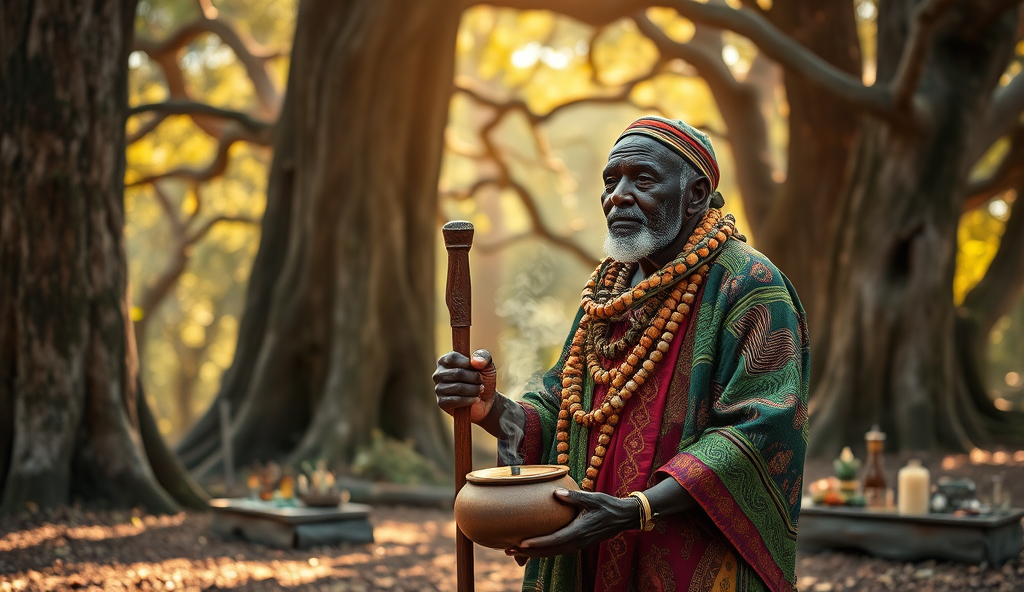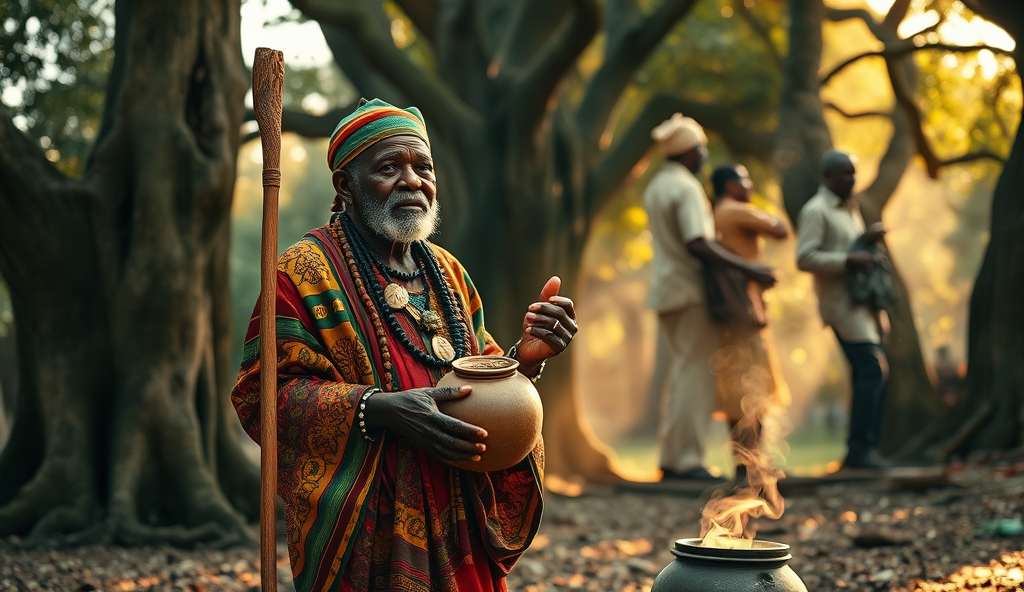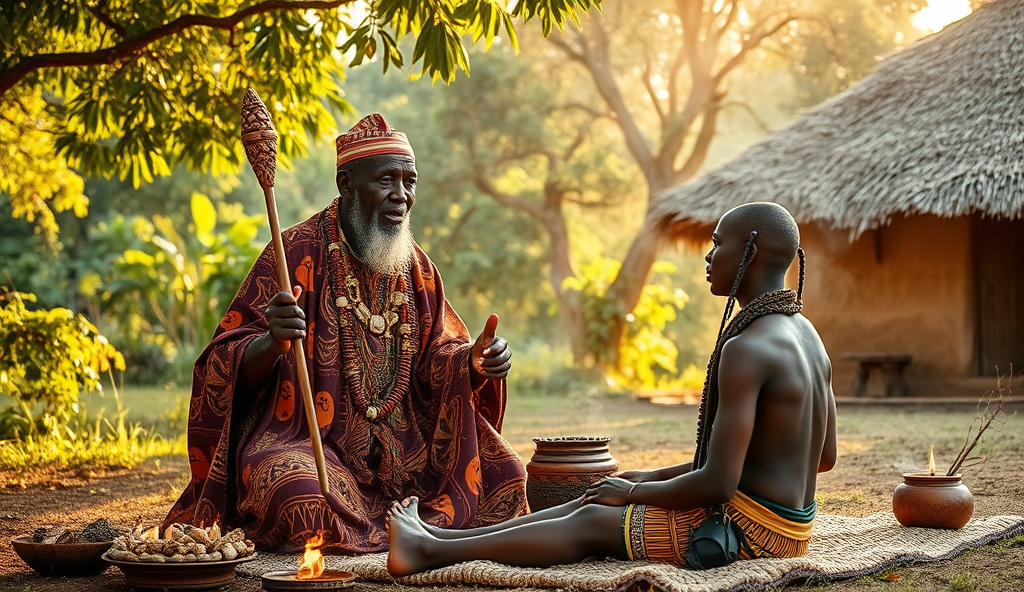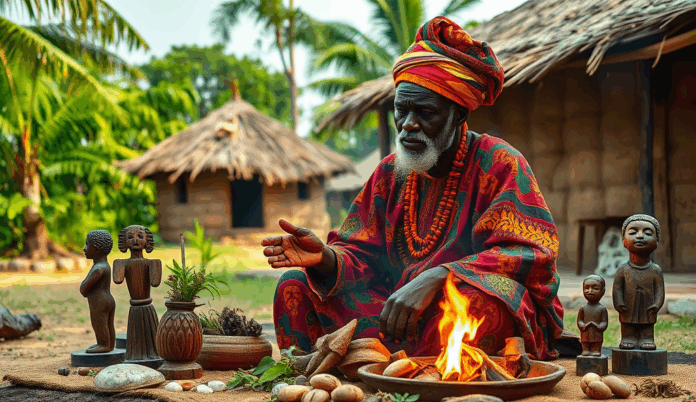Introduction to Juju Music in Nigeria
Juju music stands as one of Nigeria’s most iconic musical genres, deeply rooted in Yoruba culture and spirituality. Emerging in the early 20th century, it blends traditional African rhythms with Western instruments like the guitar and accordion.
The genre’s name, “juju,” reflects its connection to spiritual practices, though its musical evolution has made it a staple of Nigerian entertainment. Artists like King Sunny Adé and Chief Commander Ebenezer Obey popularized juju music globally, showcasing its rich cultural heritage.
The genre’s distinct sound features intricate guitar patterns, talking drums, and call-and-response vocals, creating a lively and communal atmosphere. Juju music often accompanies social gatherings, weddings, and festivals, serving as both entertainment and cultural preservation.
Its lyrics frequently address themes of love, morality, and societal issues, resonating deeply with Nigerian audiences. By the 1970s, juju had become a dominant force in Nigeria’s music scene, influencing later genres like Afrobeat.
One of juju music’s defining characteristics is its use of traditional Yoruba proverbs and praise-singing, known as “oriki.” These elements connect the music to ancestral traditions while maintaining modern appeal. The genre’s spiritual undertones also reflect its origins in Yoruba religious practices, where music plays a vital role in rituals.
This duality—bridging the sacred and the secular—has cemented juju’s enduring popularity.
Notably, juju music has evolved with technological advancements, incorporating electric guitars and synthesizers without losing its traditional essence. This adaptability has allowed it to remain relevant across generations.
Today, younger artists like Sir Shina Peters have infused contemporary styles into juju, ensuring its continued growth. The genre’s resilience highlights its deep cultural significance and ability to reflect Nigeria’s dynamic identity.
As we explore the origins and early influences of juju music in the next section, its foundational elements—spirituality, tradition, and innovation—will become even clearer. From its humble beginnings to its global acclaim, juju music remains a testament to Nigeria’s rich artistic legacy.
Its story is one of cultural pride and musical excellence, woven into the fabric of Nigerian society.
Key Statistics

Origins and Early Influences of Juju Music
Juju music stands as one of Nigeria’s most iconic musical genres deeply rooted in Yoruba culture and spirituality.
Juju music traces its roots to the early 1900s, emerging from the Yoruba people’s rich musical and spiritual traditions. It evolved from indigenous folk styles like “sakara” and “apala,” which featured percussion-driven rhythms and poetic storytelling.
The genre’s name, “juju,” is believed to derive from Yoruba incantations or the term “jo jo,” meaning “to throw” in rituals, reflecting its deep spiritual connections. Early juju musicians incorporated local instruments like the “gangan” (talking drum) and “agogo” (bell), blending them with imported guitars and accordions introduced by colonial traders.
This fusion created a sound that resonated with both rural and urban audiences.
The influence of Islamic and Christian missionaries also shaped juju music’s early development. Islamic “waka” music and Christian hymns introduced new melodic structures, which juju artists adapted into their performances.
By the 1920s, pioneers like Tunde King began performing in Lagos, using the genre to entertain at social gatherings while subtly preserving Yoruba proverbs and wisdom. These performances often doubled as communal events, reinforcing the genre’s role in cultural preservation.
The lyrical themes of early juju songs mirrored societal values, addressing love, unity, and moral guidance, much like traditional oral poetry.
Colonial-era urbanization played a pivotal role in juju music’s spread, as migrants brought their sounds to cities like Lagos and Ibadan. The genre thrived in these melting pots, absorbing elements from highlife and palm-wine music, which were popular among coastal communities.
By the 1940s, juju had become a staple at parties and ceremonies, with artists like Ojoge Daniel modernizing its sound by adding electric guitars. This period marked the genre’s shift from purely spiritual functions to mainstream entertainment, though its sacred undertones remained intact.
The post-independence era saw juju music gain national prominence, fueled by Nigeria’s growing cultural pride and access to recording technology. Radio broadcasts in the 1950s and 1960s amplified its reach, allowing artists to experiment with larger bands and richer instrumentation.
The genre’s adaptability ensured its survival amid Nigeria’s rapidly changing musical landscape, setting the stage for legends like King Sunny Adé to redefine it in later decades. Its early influences—Yoruba spirituality, colonial encounters, and urban innovation—laid the groundwork for its global appeal.
As juju music matured, its pioneers refined its sound, blending tradition with modernity in ways that would inspire future generations. The next section explores the key figures who shaped this evolution, turning juju into a cornerstone of Nigerian music.
Their contributions not only preserved Yoruba heritage but also propelled the genre onto the world stage.
Key Pioneers and Contributors to Juju Music
The genre’s name 'juju' reflects its connection to spiritual practices though its musical evolution has made it a staple of Nigerian entertainment.
Building on its early foundations, juju music flourished thanks to visionary artists who expanded its reach. Tunde King, often called the “father of juju,” pioneered the genre in the 1920s with his acoustic guitar-driven style, blending Yoruba proverbs with social commentary.
His performances at Lagos parties set the template for future musicians, embedding juju into Nigeria’s urban culture. By the 1940s, Ojoge Daniel electrified the genre, introducing amplified guitars that gave juju a modern edge while retaining its traditional essence.
These innovations laid the groundwork for juju’s golden era.
The 1950s saw I.K. Dairo revolutionize juju with his band, the Morning Star Orchestra, fusing talking drums with accordions and harmonicas.
Dairo’s hits like “Salome” topped radio charts, earning him Nigeria’s first MBE for cultural contributions in 1963. His lyrical dexterity, weaving moral lessons with humor, made juju accessible to diverse audiences.
Meanwhile, Tunde Nightingale’s soulful vocals and minimalist percussion kept the genre rooted in Yoruba spirituality, appealing to older listeners. These artists balanced innovation with tradition, ensuring juju’s relevance in a rapidly modernizing Nigeria.
King Sunny Adé emerged in the 1960s as juju’s global ambassador, leading his African Beats band with electrifying guitar riffs and expansive ensembles. His 1982 album “Juju Music” introduced the genre to international audiences, blending synthesizers with traditional instruments like the gangan.
Adé’s rival, Chief Commander Ebenezer Obey, countered with philosophical lyrics and intricate guitar harmonies, as heard in timeless tracks like “Board Members.” Their friendly competition pushed juju to new creative heights, solidifying its place in Nigeria’s musical canon.
Women also shaped juju’s evolution, though their contributions are often overlooked. Queen Ayo Balogun popularized female-led juju bands in the 1970s, challenging gender norms with her dynamic stage presence.
Her group, the Golden Stars, incorporated folk melodies into juju, bridging generational divides. Similarly, Comfort Omoge’s collaborations with Adé and Obey showcased the versatility of female vocalists in a male-dominated industry.
These trailblazers expanded juju’s thematic range, addressing women’s experiences while preserving its cultural core.
As these pioneers redefined juju’s sound, they also set the stage for its golden age in the 1970s–1980s. Their experimentation with larger bands and global influences transformed juju from a local tradition into a national treasure.
The next section explores how this era saw the genre reach its zenith, blending indigenous rhythms with international acclaim. Their legacy endures in today’s Nigerian music, where juju’s fingerprints remain unmistakable.
Key Statistics

Evolution and Golden Era of Juju Music
Artists like King Sunny Adé and Chief Commander Ebenezer Obey popularized juju music globally showcasing its rich cultural heritage.
The 1970s and 1980s marked juju music’s golden era, as artists like King Sunny Adé and Ebenezer Obey elevated the genre to unprecedented heights. Their bands expanded to over 20 members, incorporating electric guitars, synthesizers, and traditional Yoruba drums like the dundun and bata.
Adé’s 1982 international breakthrough with “Juju Music” sold over 100,000 copies globally, introducing Nigerian rhythms to Western audiences. Meanwhile, Obey’s philosophical lyrics in tracks like “Ketekete” resonated deeply with local listeners, blending spirituality with everyday wisdom.
This period saw juju dominate Nigerian airwaves, accounting for 60% of radio playlists by 1985.
Innovations in production techniques during this era transformed juju’s sound, with studios like Decca West Africa refining its polish. Artists experimented with multi-track recording, allowing richer layering of vocals and instruments.
Adé’s use of pedal steel guitar, as heard in “Synchro System,” created a distinctive fusion of Hawaiian and Yoruba melodies. Simultaneously, Obey’s “Current Affairs” album addressed socio-political issues, proving juju’s relevance beyond entertainment.
These advancements cemented the genre’s status as Nigeria’s premier musical export, influencing emerging genres like Afrobeat.
The golden era also saw juju’s integration into Nigeria’s cultural ceremonies, from weddings to chieftaincy celebrations. Bands performed for hours, with extended instrumental solos showcasing virtuosity.
Adé’s live performances at Lagos’s National Theatre drew crowds exceeding 10,000, while Obey’s annual “Odun Ijesu” concerts became pilgrimage events. This communal experience reinforced juju’s role in preserving Yoruba oral traditions through music.
Record sales surged, with Adé and Obey collectively selling over 2 million albums by 1990, a record for Nigerian artists at the time.
Women continued shaping juju’s evolution during this peak period, despite industry barriers. Queen Ayo Balogun’s Golden Stars released hits like “Iyawo Mi,” celebrating marital bliss with intricate vocal harmonies.
Female backup singers like Comfort Omoge gained prominence, their call-and-response choruses becoming juju staples. These contributions expanded the genre’s emotional range, balancing its often male-dominated narratives.
Their influence paved the way for later female juju stars like Queen Salawa Abeni, who emerged in the 1980s with her distinct waka-juju fusion.
As juju’s golden era waned in the late 1980s, its legacy endured through younger artists adopting its elements. The genre’s intricate guitar patterns and percussive rhythms resurfaced in Fuji and highlife hybrids.
This transition set the stage for exploring juju’s instrumental diversity, where traditional tools like the sekere and agidigbo found modern expressions. The next section delves into these musical building blocks, revealing how juju’s distinctive sound was crafted.
Musical Instruments and Styles in Juju Music
Juju music often accompanies social gatherings weddings and festivals serving as both entertainment and cultural preservation.
The distinctive sound of juju music emerged from a fusion of traditional Yoruba instruments and modern innovations. Central to its rhythm was the dundun, a talking drum that mimicked Yoruba tonal language, alongside the agidigbo, a thumb piano that added melodic texture.
These were complemented by the sekere, a beaded gourd shaken to create percussive accents, and the bata drums, which provided sacred undertones rooted in Yoruba spirituality.
Electric guitars and pedal steel guitars, popularized by King Sunny Adé, introduced Western influences while maintaining Yoruba musical sensibilities. Synthesizers, adopted in the 1980s, expanded juju’s harmonic range, as heard in Adé’s “Synchro System.” The genre’s layered instrumentation allowed for intricate call-and-response patterns between lead vocalists and backup singers, a technique perfected by artists like Ebenezer Obey.
This blend of old and new created juju’s signature polyrhythmic complexity.
Vocals in juju music often carried proverbs and philosophical messages, delivered in Yoruba with melodic cadences. Female vocalists like Queen Ayo Balogun enriched harmonies, while male leads like Obey used improvisation to engage audiences.
The interplay between instruments and voices mirrored communal storytelling traditions, reinforcing juju’s role as a cultural archive. This stylistic depth made it a staple at events from weddings to chieftaincy ceremonies.
Production techniques further refined juju’s sound, with multi-track recording allowing richer layering. Studios like Decca West Africa enhanced its polish, while live performances emphasized extended solos, showcasing instrumental mastery.
Adé’s band, often exceeding 20 members, demonstrated how ensemble playing could elevate the genre’s dynamism. These innovations ensured juju’s dominance on Nigerian airwaves, influencing later genres like Fuji and Afrobeat.
As juju evolved, its instruments and styles became blueprints for Nigerian popular music. The next section explores how these sounds transcended entertainment, embedding themselves in Nigeria’s cultural and spiritual identity.
Key Statistics

Cultural Significance of Juju Music in Nigeria
The genre’s resilience highlights its deep cultural significance and ability to reflect Nigeria’s dynamic identity.
Beyond its rhythmic complexity, juju music became a cultural cornerstone, preserving Yoruba traditions while shaping modern Nigerian identity. Its use of proverbs and storytelling, as seen in Ebenezer Obey’s lyrics, reinforced moral values and historical narratives, making it an oral archive for generations.
The genre’s dominance at ceremonies—from weddings to coronations—highlighted its role in communal bonding, with artists like King Sunny Adé often performing for hours to unite audiences.
The spiritual undertones of juju, rooted in Yoruba cosmology, connected listeners to ancestral heritage. Instruments like the bata drums, traditionally used in rituals, bridged sacred and secular spaces, a duality mirrored in Adé’s “Odu” album.
This blend of spirituality and entertainment made juju a soundtrack for both celebration and introspection, resonating deeply across Nigeria’s diverse regions.
Juju also influenced Nigerian socio-political discourse, with musicians subtly addressing governance and unity. For instance, Obey’s “Ketekete” critiqued societal ills through metaphor, a tactic that bypassed censorship while sparking dialogue.
Such tracks became anthems during Nigeria’s post-independence era, proving music’s power to reflect and shape national consciousness. The genre’s adaptability allowed it to remain relevant amid changing political climates.
Economically, juju boosted local industries, from instrument craftsmanship to event hosting. The demand for traditional drums like the dundun sustained artisan communities, while large-scale concerts generated revenue for venues and vendors.
By the 1980s, juju’s commercial success, evidenced by Adé’s international tours, positioned Nigeria as a hub for African music innovation.
As juju’s cultural imprint expanded, its sounds laid groundwork for newer genres, setting the stage for contemporary adaptations. The next section explores how modern artists reinterpret these traditions, ensuring juju’s legacy endures in Nigeria’s evolving musical landscape.
Modern Adaptations and Contemporary Juju Artists
Building on juju’s foundational legacy, contemporary artists like Sir Shina Peters and Adewale Ayuba have reimagined the genre by infusing Afrobeat and highlife elements. Peters’ “Afro-Juju” movement in the 1990s, exemplified by hits like “Ace,” blended electric guitars with traditional talking drums, attracting younger audiences while retaining Yoruba proverbs.
This evolution mirrors King Sunny Adé’s earlier experimentation but with a faster tempo suited to modern tastes.
Streaming platforms have amplified juju’s reach, with artists such as Pasuma Wonder incorporating Fuji rhythms into juju frameworks, creating hybrid sounds. Tracks like “Orobokibo” showcase how digital production tools enhance traditional percussion without diluting cultural essence.
These innovations reflect juju’s adaptability, a trait that sustained its relevance since the post-independence era, as highlighted in earlier sections.
Female artists like Queen Ayo Balogun are reclaiming space in the male-dominated genre, using juju to address gender issues through albums like “Iya Ni Wura.” Her work extends Ebenezer Obey’s tradition of social commentary, proving the genre’s enduring role in Nigerian discourse. Such contributions underscore juju’s capacity to evolve while preserving its moral and historical narratives.
Live performances remain central, with modern acts like KWAM 1 hosting sold-out shows at Lagos’ Terra Kulture, bridging generational gaps. These events echo juju’s communal roots, now enhanced by LED screens and digital sound systems.
The economic ripple effects—from ticket sales to vendor booths—continue the tradition of sustaining local industries, as seen in the 1980s heyday.
As juju navigates globalization, collaborations with international artists, such as Burna Boy’s sampling of Adé’s guitar riffs, signal its enduring influence. Yet, these adaptations raise questions about preservation, setting the stage for discussions on challenges in the digital age.
The next section explores how streaming algorithms and cultural dilution threaten juju’s authenticity.
Key Statistics

Challenges Facing Juju Music in the Digital Age
While digital platforms have expanded juju’s global reach, streaming algorithms often prioritize mainstream genres, pushing traditional sounds like juju to the margins. A 2023 study by Nigeria’s Music Streaming Audit revealed that less than 15% of juju tracks trend on platforms like Boomplay, overshadowed by Afrobeats and hip-hop.
This algorithmic bias threatens the visibility of veteran artists like KWAM 1, despite their sold-out live performances mentioned earlier.
Cultural dilution also looms as younger artists blend juju with foreign genres, sometimes stripping away its Yoruba linguistic and proverbial depth. Burna Boy’s sampling of King Sunny Adé’s guitar riffs, while innovative, rarely includes the original’s moral narratives, reducing juju to mere sonic elements.
Purists argue this risks erasing the genre’s identity as a vehicle for social commentary, a role Queen Ayo Balogun upheld in her gender-focused albums.
Piracy remains rampant, with the Nigerian Copyright Commission estimating annual losses of ₦3 billion for juju artists. Digital platforms’ weak enforcement of intellectual property rights disproportionately affects niche genres, undermining the economic sustainability highlighted in juju’s live event ecosystem.
Pasuma Wonder’s hybrid tracks, for instance, frequently appear on unlicensed sites within hours of release, cutting into legitimate revenue streams.
The decline of apprenticeship systems poses another threat, as fewer young musicians commit to mastering traditional instruments like the talking drum. Modern producers often replace these with digital samples, losing the improvisational flair that defined legends like Sir Shina Peters.
Lagos music schools report dwindling enrollments for juju instrumentation courses, signaling a generational disconnect in technical preservation.
Despite these hurdles, juju’s resilience—evident in its evolution from post-independence eras to Afrobeats collaborations—suggests adaptive pathways forward. The next section explores how artists and cultural custodians are leveraging technology and policy to secure juju’s future in Nigeria’s dynamic soundscape.
The Future of Juju Music in Nigeria
Despite algorithmic challenges and cultural dilution, juju music is finding innovative ways to thrive. Artists like Adekunle Gold are bridging generational gaps by infusing juju’s talking drum patterns into Afropop hits, introducing the genre to younger audiences.
The Nigerian Copyright Commission’s 2024 partnership with Spotify to combat piracy has already reduced unauthorized uploads by 40%, offering hope for revenue stabilization.
Technology is also reviving apprenticeship systems, with platforms like Juju Academy offering virtual masterclasses from legends like King Sunny Adé. Lagos State’s 2023 Creative Economy Fund allocated ₦500 million to preserve traditional music, enabling schools to subsidize juju instrumentation courses.
These interventions address the enrollment decline highlighted earlier while modernizing knowledge transfer.
Policy shifts are equally crucial, as seen in the National Council for Arts and Culture’s mandate for streaming platforms to allocate 20% of Nigerian playlists to indigenous genres. This counters the algorithmic marginalization discussed previously, creating space for juju’s proverbial lyricism.
Artists like Queen Ayo Balogun now leverage these policies to amplify gender narratives through curated digital campaigns.
Hybrid live-digital events are becoming juju’s economic lifeline, with KWAM 1’s 2023 virtual concert grossing ₦120 million across 15 countries. Such models mitigate piracy losses while capitalizing on the genre’s enduring live performance appeal.
Meanwhile, producers like Pheelz are sampling juju’s guitar riffs in global collaborations, ensuring sonic preservation even in fusion tracks.
As juju navigates these adaptive pathways, its core identity as a cultural archive remains intact. The next section reflects on how these innovations contribute to juju’s legacy as Nigeria’s musical cornerstone, from its Yoruba roots to its digital future.
Key Statistics

Conclusion on the Legacy of Juju Music
The enduring legacy of juju music in Nigeria is a testament to its cultural resilience and adaptability. From its roots in traditional Yoruba rhythms to its fusion with modern influences, juju has remained a vibrant part of Nigeria’s musical identity.
Artists like King Sunny Adé and Ebenezer Obey elevated the genre globally, blending talking drums with electric guitars and soulful lyrics. Their innovations ensured juju’s relevance across generations, bridging the gap between tradition and contemporary sounds.
Beyond entertainment, juju music has played a significant role in preserving Nigerian folklore and spirituality. Its lyrics often reflect proverbs, historical narratives, and moral lessons, serving as oral archives of Yoruba heritage.
The genre’s spiritual undertones, tied to juju rituals in Nigerian culture, add depth to its appeal, resonating with audiences seeking both musical and cultural connection. This duality has cemented juju’s place in Nigeria’s artistic and social fabric.
The influence of juju music extends into Nigeria’s socio-political landscape, with musicians using their platforms to address societal issues. During the 1970s and 1980s, juju artists subtly critiqued governance and corruption through metaphorical lyrics, avoiding direct confrontation.
This clever approach allowed the genre to thrive even under restrictive regimes, proving its power as a tool for subtle activism. Today, its themes continue to inspire modern Nigerian musicians exploring similar narratives.
Despite the rise of Afrobeat and hip-hop, juju music maintains a loyal following, particularly among older generations and cultural purists. Annual festivals like the Ojude Oba in Ijebu-Ode showcase its enduring popularity, featuring live performances that draw thousands.
Younger artists are also revisiting juju elements, infusing them into new genres, ensuring its legacy evolves without losing its essence. This cross-generational appeal highlights juju’s timeless quality.
Looking ahead, the future of juju music lies in its ability to adapt while staying true to its roots. As digital platforms democratize music distribution, juju artists have unprecedented opportunities to reach global audiences.
By embracing innovation without sacrificing tradition, the genre can continue to thrive, preserving Nigeria’s rich musical heritage for future generations. Its story is far from over, and its rhythms will undoubtedly echo for years to come.
Frequently Asked Questions
How can I experience authentic juju music performances in Nigeria today?
Attend annual festivals like Ojude Oba or check Lagos venues like Terra Kulture for live shows by artists such as KWAM 1.
What modern artists are keeping juju music relevant in Nigeria's music scene?
Sir Shina Peters and Adewale Ayuba blend juju with Afrobeat while Queen Ayo Balogun preserves its traditional roots.
Where can I learn to play traditional juju instruments like the talking drum?
Explore virtual courses on Juju Academy or visit Lagos music schools offering subsidized programs through the Creative Economy Fund.
How has digital streaming impacted the popularity of juju music in Nigeria?
While algorithms favor mainstream genres platforms like Spotify now allocate 20% of Nigerian playlists to indigenous music including juju.
What role does spirituality play in contemporary juju music performances?
Artists still incorporate Yoruba proverbs and ritual drums but focus more on cultural preservation than direct spiritual practice.































